Imagination Announces PowerVR Series7 GPUs - Series7XT & Series7XE
by Ryan Smith on November 10, 2014 8:50 AM EST- Posted in
- GPUs
- Mobile
- Imagination Technologies
- PowerVR
- PowerVR Series7
Series7XT In Detail
Now that we’ve had a chance to look at the common Series7 architecture, let’s take a look at the features and properties of Series7XT in particular.
Series7XT will be offered with 2 optional feature additions. The first is the aforementioned FP64 ALU, which is being offered as part of what Imagination is calling the HPC Feature Pack. As FP64 operations are not necessary for graphics work (and often even FP16 will do), the FP64 functionality is being offered to customers who want to build HPC hardware out of Series7XT. PowerVR hardware has up until now not been a competitor in the HPC space, so this marks a significant turning point for Imagination and would have them challenging frontrunner NVIDIA in this space. Also of note here, as the base 7XT configuration only supports OpenCL 1.2 Embedded Profile, the HPC pack upgrades 7XT’s OpenCL capabilities to 1.2 Full Profile.
Meanwhile the other optional feature pack for Series7XT is the Direct3D 11 pack, which is primarily geared towards customers who would be building Windows Phone and Windows RT devices. Imagination made Direct3D 11 an optional feature on 6XT, and is doing the same on 7XT. In the case of 6XT the D3D option would have added the necessary tessellation capabilities that are now default on 7XT, so for 7XT this is likely more about D3D features such as S3TC that require additional licensing.
Moving on, for as much as Imagination’s various enhancements ultimately improve performance, really it’s power efficiency that’s driving most of Imagination’s performance gains, and 7XT in turn is designed to further improve on Imagination’s power efficiency. Unfortunately Imagination isn’t throwing out any numbers here – just that 7XT can offer similar performance as 6XT for less power – but on the subject of power efficiency they have documented their efforts to deal with throttling.
To be clear here this is a matter ultimately in the hands of SoC integrators and is not something Imagination can directly control, but as a supplier they can offer advice and suggestions to their customers to improve the experience. Short of making PowerVR GPUs low power in the first place (and this is something everyone in this space tries to do), the next best thing they can do is to encourage customers to be mindful of throttling and to discourage designing their clockspeed governors to be bursty. While the “hurry up and go to sleep” motto makes a lot of sense for CPUs, it makes less sense for GPUs due to the fact that most workloads are sustained. By providing good real-time power usage data to the OS and by discouraging high maximum clockspeeds that lead to burst-and-throttle behavior from governors, for Series7 Imagination is at least trying to ensure that throttling is minimized.
Finally, Imagination has outlined the different configurations that Series7XT will be available in. Starting in 2 cluster configurations, 7XT scales up to 16 cluster configurations, or twice as large as 6XT. 2-4 cluster configurations are expected to be used in phones and TVs, meanwhile 6-8 cluster configurations are expected to be used in tablets, automotive, and ultrabooks. Finally the 16 cluster configuration would be targeted at non-traditional spaces for PowerVR products, such as full notebooks, dedicated (set-top) gaming devices, and servers. With a hefty 512 FP32 ALUs Imagination expects that the 16 cluster configuration should rival lower-end discrete GPUs, which would certainly be the competition for the device categories that Imagination is chasing.
Series7XE In Detail
Moving on, at the other end of the spectrum we have the Series7XE GPUs. These products are the successors to the Series6XE GPUs, and like their predecessors are focused on a narrower feature set for low cost devices, with an emphasis on area efficiency over power efficiency.
Of the Series7 features we’ve covered so far, Series7XE gains access to virtually all of those features. However a larger number of those features are optional and are not in the base configuration. Of note, all of the general enhancements for the frontends and the USC are carried over for the base configuration. However the tessellation block (and hence AEP support) is optional.
As a result 7XE has 4 optional feature packs to build on top of its base OpenGL ES 3.1 functionality. The AEP adds the tessellator and other AEP-centric functionality from 7XT that isn’t in 7XE’s default configuration. Meanwhile the Compression Pack segregates certain compression features from 7XE so that they’re only included in designs that need them (since SoC manufacturers may want to use 3rd party compression technology). HEVC and 10-bit YUV support is also optional for 7XE, and finally the virtualization features we discussed earlier are optional as well.
Since 7XT is targeted at 2 cluster and above configurations, 7XE is designed to cover the 1 and ½ cluster configurations. This results in 2 configurations, the GE7800 which implements a full cluster, and the GE7400 which implements a half-cluster. With the 1 cluster configuration targeted at low-end phones and TVs, the half-cluster configuration will be in the cheapest and simplest devices, along with being a candidate for high-end wearable devices.
Imagination says that at the low clockspeeds they’re envisioning for 7XE wearables, the full load power for the GPU would be under 1W, with low/idle power consumption of course being much lower yet. Any kind of power consumption approaching 1W definitely also approaches a “high-end” niche for wearables, but none the less it is viable if for any reason someone needed to build a wearable device that could handle OpenGL ES 3.1 graphics.


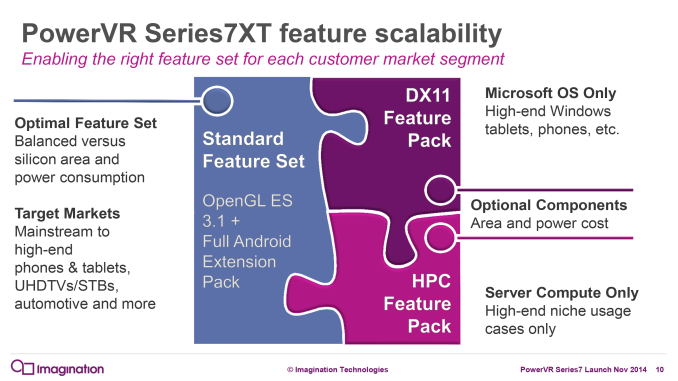
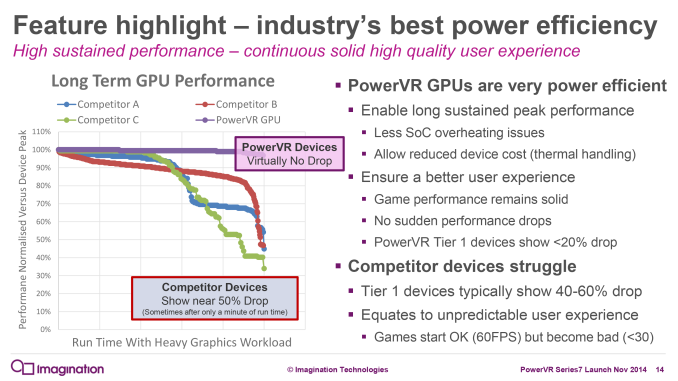
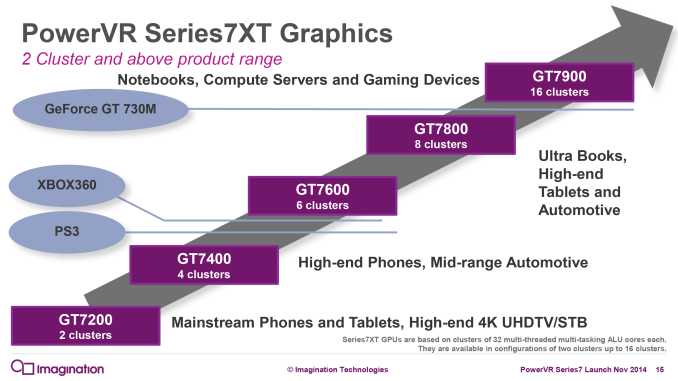
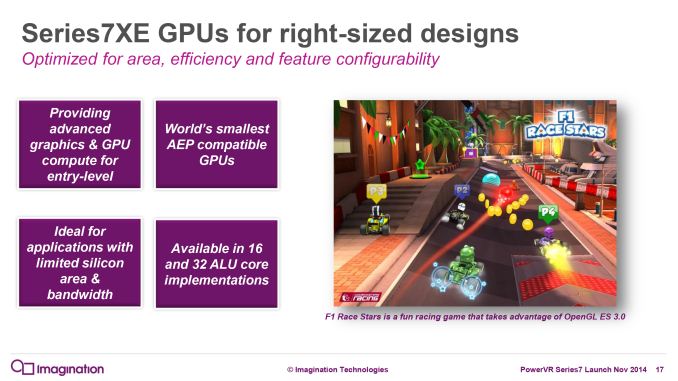
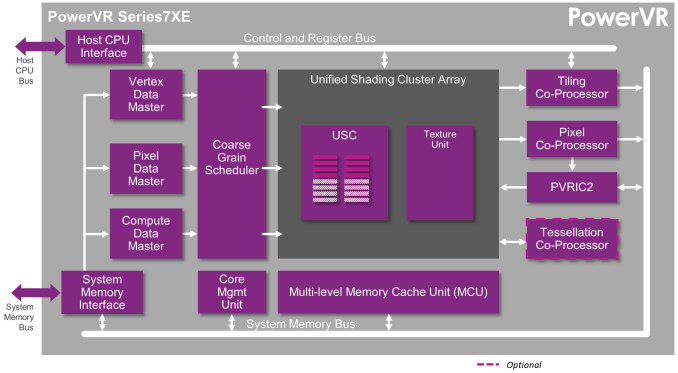
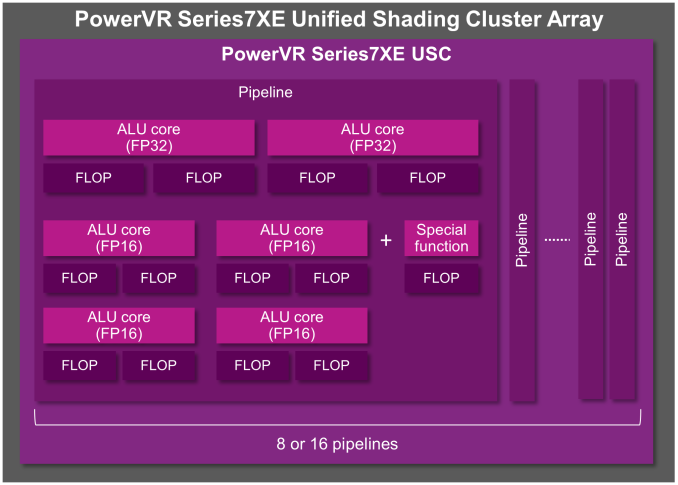
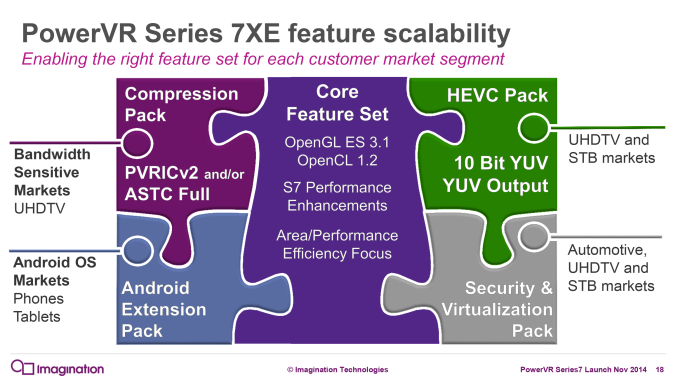









49 Comments
View All Comments
chizow - Monday, November 10, 2014 - link
Nvidia GPU SoC tech can be licensed, it just hasn't happened (yet).takeship - Tuesday, November 11, 2014 - link
Nvidia SoC tech can't be licensed. The terms they've put out are intentionally prohibitative. What the can do though, and have done, is legally claim to offer "licenses", and then sue all the market players when no one opts to spring for it and price themselves out of the market. Which is also what they've done.chizow - Wednesday, November 12, 2014 - link
And you know this how? I think the various lawsuits ongoing will be the impetus to establish the first licensees of Nvidia IP.hahmed330 - Monday, November 10, 2014 - link
In such a high end configuration why bother with FP16 Flops. It's a waste of die space. How relevant is FP16 in mobile configurations though nowadays? How huge is the quality degradation on a 7 inch screen?Ryan Smith - Monday, November 10, 2014 - link
"How relevant is FP16 in mobile configurations though nowadays?"Actually, very. FP16 is still significantly used because it can deliver the necessary quality at lower power. Games will tend towards FP32, but for desktop composition and such FP16 is more than plenty and is a task the GPU is frequently doing.
lefty2 - Tuesday, November 11, 2014 - link
When you use "lowp" in your shader it is using FP16. Shaders written for mobile games typically use lowp as much as possible, as it greatly increases performance, but desktop GPUs do not use them at all.coder111 - Monday, November 10, 2014 - link
Ok, so are they going to provide proper Linux drivers?http://en.wikipedia.org/wiki/Free_and_open-source_...
If not, they SUCK!
On the other hand, seeing mobile devices/tablets get similar level of GPU as dedicated consoles like PS3 and xbox360 is nice. Well, ok, ps3 and xbox360 are now 1 generation old, but still these are MOBILE GPUs.
GC2:CS - Monday, November 10, 2014 - link
"Though the first PowerVR Series 6XT-equipped products have only recently launched – including the unexpectedly powerful iPad Air 2..."You stole that from my mounth.... iPad Air 2 has an insanely fast GPU, they just kind of crushed it in that area.
The A8X matches the best nvidia offering at significally lower power with insane sustained performance.
And now you got an Series 7 GPU's... With rumors of Apple pushing heavilly for an 16nm Fin Fet Plus proces from TSMC which got some big power savings coupled with these GPU's... I think we will see that yearly doubling of GPU performance once more (and possibly last time, at least until we are stucked with silicone).
The question is, how big those are, with series 6XT we saw a 50% efficiency gain, but a far bigger GPU size as well. As TSMC 16FF+ is not that much of a shrink at all it could be a problem going with an even bigger architecture.... Even then an A9 and A9X build on a mature 20nm process with GT7400/7600 and somewhat higher clock speeds could bring some prety big improvements as well.
Then there is nvidia, can Apple defeat them like this year ?
Or will nvidia finaly show what they can do for mobile ?
pSupaNova - Monday, November 10, 2014 - link
I think you have it the wrong way round.Nvidia has the more powerful CPU core uses less transistors and was running on a worse process.
While if you bothered to read this article has implemented more functions in its GPU Tessellation, DirectX 11, OpenGL 4.4 & Android Extension Pack.
Anandtech has the K1 tabs beating the IPad Air in the GPU tests.
http://www.anandtech.com/show/8670/google-nexus-9-...
lucam - Monday, November 10, 2014 - link
Really? It seems (from preliminary results) the Nexus 9 is behind, although the difference is negligible.We must have different interpretations of numbers and words...